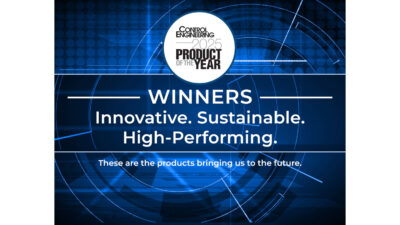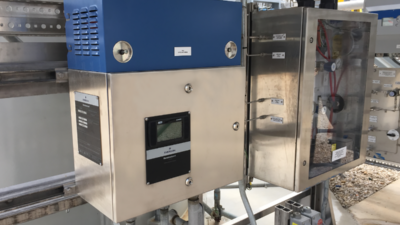Despite the tendency to cram every bit of control and automation logic into a programmable logic controller (PLC) or distributed control system (DCS), there are times when a "built-for-purpose" device makes sense. One of those times is when precise, repeatable transfers of valuable products must be made between vessels.
Despite the tendency to cram every bit of control and automation logic into a programmable logic controller (PLC) or distributed control system (DCS), there are times when a “built-for-purpose” device makes sense. One of those times is when precise, repeatable transfers of valuable products must be made between vessels.
Speed is the key advantage of using a dedicated, built-for-purpose, microprocessor-based material transfer (batch) controller. The microprocessor can execute the controller’s logic several times faster than the fastest PLC or DCS, thus more precisely hitting transfer targets.
Several material transfer controllers are available in the market that use high-speed logic solving to read and integrate input values and then decrease a valve’s position, or slow a pump as the actual transfer value approaches the target value. When the actual value equals the target, the controller finishes closing the valve or stopping the pump. This traditional control logic can produce accurate and repeatable material transfers, but it does so at the expense of material transfer cycle times.
Adding ‘intelligence’
Most of today’s material-transfer controllers are microprocessor based and use similar logic. However, when the material-transfer controller includes the processing “horsepower” to also perform a real-time predictive adaptive control (PAC) algorithm, the controller can hit the material transfer targets and do it in the least amount of time.
That’s exactly what Mettler Toledo (Columbus, O.) is doing with its recently released Q.i material-transfer controller: adding the intelligence to make precise, repeatable material transfers in the least possible time.
Working with Proctor & Gamble (P&G, Cincinnati, O.), Mettler Toledo has obtained exclusive rights to the PAC algorithm developed and widely used by P&G to minimize cycle-times while achieving precise, repeatable material transfers.
P&G’s real-time PAC technology account for instrument reading lags, material-in-suspension, valve let-through, and material kinetic forces, using the data to predict the exact moment of cut-off for optimum accuracy. To meet varying application requirements, the Q.i controller includes the:
Spill only algorithm to control material movements that have very low flow rates;
K1 algorithm to control material movements that have moderate flow rates; and
K2 algorithm to control high flow rates. Because the PAC algorithm uses real-time adaptive technology, no models need to be developed, and PAC technology automatically tunes the algorithm to compensate to normal variations that occur in each material transfer. Among the variables PAC automatically compensates for are:
Material density;
Flow rate;
Valve characteristics (speed/let-through); and
Pump performance.
Master/slave
In a PLC or DCS control and automation architecture, Mettler Toledo’s Q.i controller serves as a slave, getting material transfer recipe instructions from the “master” control system. I/O devices directly involved in material transfers (i.e., weigh-cells, flowmeters, valves, pumps, etc.) are wired directly to the appropriate Q.i controller(s), and a communication handshake is established between the master and the slave(s) it manages.
Currently the Q.i controller supports communication with Rockwell Automation’s PLC5 and CLX platforms using ControlNet. Mettler Toledo says it will soon add ABB, Emerson, Honeywell, and Siemens master/slave interfaces.
The Q.i controller has a fairly robust front-panel operator interface (OI), but according to Mettler Toledo spokespersons, the OI is enabled only when Q.i is functioning as a stand-alone controller and is disabled in master/slave control configurations. That means when Q.i is used in a master/slave architecture, all operator interface activities, such as halting a transfer or manually “tweeking” an addition, must be initiated and managed from the PLC or DCS operator interface. Thus, security, batch transfer data, and other batch recipe-related information necessary to maintain historical data integrity are communicated to and maintained in the customers “official” data historian system and not in the Q.i controller.
Asset management option
Consistent with other control and instrumentation suppliers, Mettler Toledo offers Q.i365, an asset-management option designed to ensure Q.i installations perform at maximum ability.
Q.i365 combines Internet-enabled software, collaborative production management and financial modeling tools, predictive/preventive diagnostics, and a team of experts who regularly monitor, analyze, and report to customers detailed information about material-transfer system performance.
All features and functions available in the new Q.i controller can be added to existing Mettler Toledo Jagxtreme terminals with an available upgrade kit.
For more on Mettler Toledo’s Q.i controller, visit www.mt.com , or go to www.controleng.com/freeinfo .
Four Material Transfer Case Histories Comparing Previous System to Mettler Toledo Q.i
Material
Repeatable accuracy of previous system
Repeatable accuracy of Q.i system
Percent improvement
Source: Control Engineering with data from Mettler Toledo
Molasses
2.2%
0.3%
86.4%
Water
0.11%
0.04%
63.6%
Sugar
0.18%
0.067%
62.8%
Flavoring
1.44%
0.04%
97.22%



